
Entering the European market for food tourism
The European food tourism market is very large. Food safety and local regulations are at the centre of preparing food travel products for the European market. To be a successful food tourism provider, you need local knowledge and involvement. They are key to ensuring authentic, immersive and sustainable experiences. European tourists often use OTAs (online travel agents) to book food experiences. This means that OTAs offer local operators a convenient way to reach this large market of travellers.
Contents of this page
- What requirements and certifications must food tourism meet to be allowed on the European market?
- Through which channels can you get food tourism products on the European market?
- What competition do you face on the European food tourism market?
- What are the prices of food tourism on the European market?
1. What requirements and certifications must food tourism meet to be allowed on the European market?
The European tour operator market has to comply with various regulations so that its clients are safe and financially protected. To do business with the European market, your business processes need to meet their expectations. European tour operators expect you to meet conditions set out in a code of conduct or their terms of business. Sustainability in all areas of tourism provision is important for all European tourism suppliers. You need to include sustainable actions in all your business activities.
What are the mandatory and additional requirements that buyers have?
Mandatory and additional requirements for food tourism services are common throughout the tourism sector. They include:
- The European Package Travel Directive;
- General Data Protection Regulation (GDPR);
- Liability insurance and insolvency protection.
You can find out more in the CBI study 'What requirements must tourism services comply with to be allowed on the European market?'. It will help you understand the legal, non-legal and common requirements that European tour operators have to comply with. If you know what they need to do and can adapt your business to meet their needs, they will be more likely to do business with you. European buyers have to trust their suppliers to meet their customers’ needs.
What are the requirements for niche markets?
Generally, food tourism businesses have to work in line with local regulations on the preparation and serving of food to keep consumers safe. Supporting these with recognised food safety standards will help customers feel safer. Understanding the benefits of food tourism to a community and place will help make sure that experiences are authentic and sustainable. Carefully planning food experiences is essential, and it is important to factor in market changes. A website and good use of social media are important for both marketing and sales.
Implement local regulations to serve food/drink to the public
Places and businesses that serve food to the public are subject to a wide range of regulations to keep their customers safe. You need to be aware of regulations about the handling and serving of food at your destination. You may need to register your business and have a licence to serve food. Check these requirements with the relevant authorities, such as local government departments, public health authorities and the local council.
If you work with local suppliers to provide a food experience, be sure that they conform with all the local regulations.
Food safety and hygiene around the handling, storing, preparation and serving of food are very important for providers of food tourism products. The World Health Organisation (WHO) estimates that 600 million people fall ill after eating contaminated food every year, and almost half a million people die from food-based diseases that can be bacterial, viral or chemical.
The WHO has published five ‘keys to safer food’. These promote safe practices for consumers and food handlers, such as restaurants, cafés and street food vendors.
Figure 1: Five keys to safer food
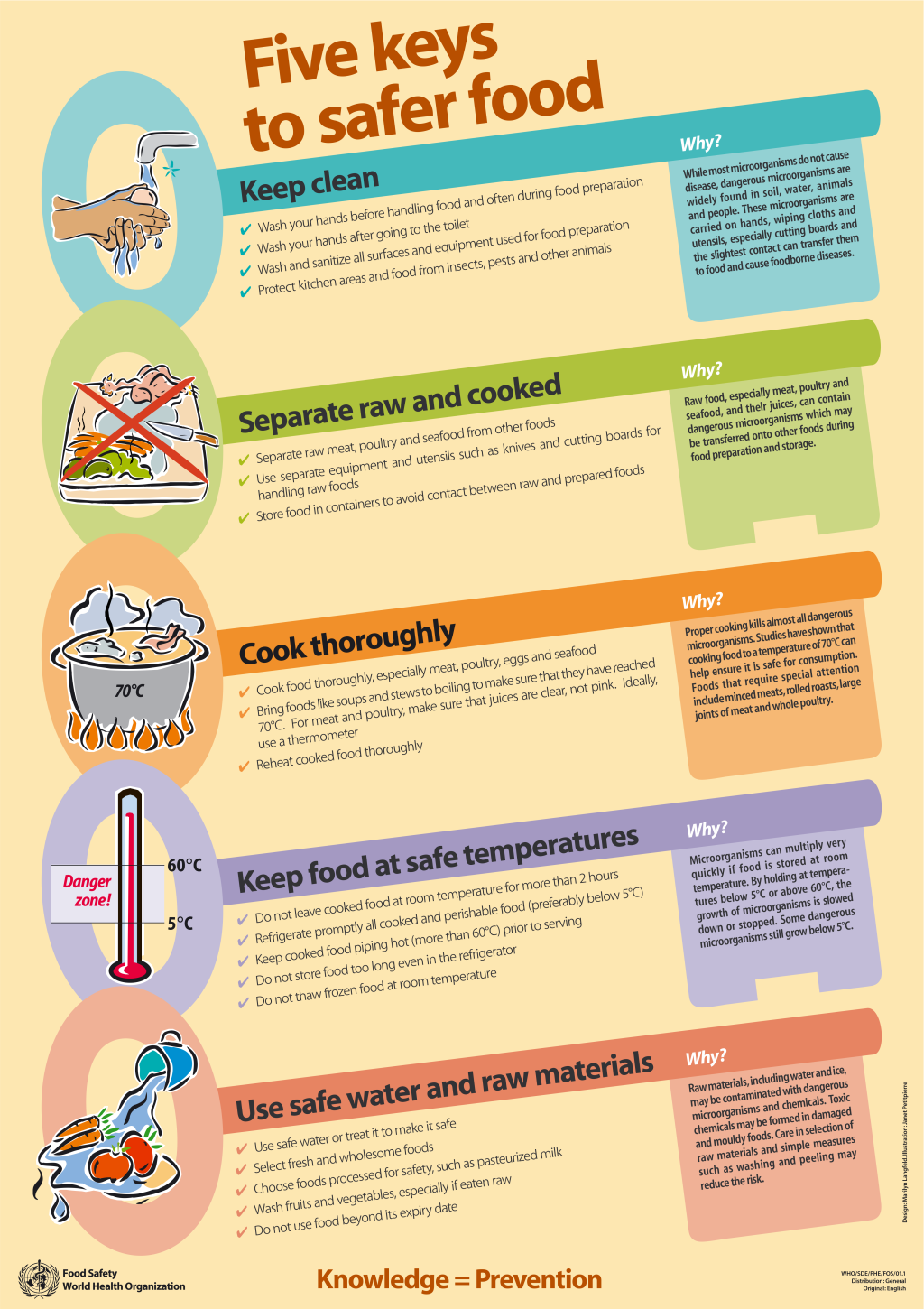
Source: WHO, 2025
Download the five keys poster and put it up in your kitchen or office to help your staff understand the importance of cleanliness and proper food handling. It is available in many languages. Read the WHO’s Food Safety factsheet for more information about the importance of good food management.
Depending on the rules in your country, you need to be very clear about serving and consuming alcohol, particularly if it is forbidden.
Put in place robust food safety standards
If your business serves food directly to tourists, consider implementing the ISO 22000:2018 Food Safety Management Standard. This tells businesses what they need to do to manage food safety hazards and ensure food safety. European operators are more likely to want to do business with you if you can show that food safety is important for you. As of June 2025, there is a 10% discount on purchasing the standard and the accompanying guide.
Download this free brochure to learn about the standard and its benefits for your business. Then browse the other articles on this page to learn more.
Develop authentic and sustainable food tourism experiences
The market for food travel products is very large and very varied. This creates lots of good opportunities for local tour operators to enter the market. Developing authentic and meaningful food experiences that enable visitors to engage with local communities and people is key to creating successful and sustainable tourism products.
As can be seen in the list below, there are a lot of different types of food experiences. Many overlap, and there are many ways you can use them in your food tourism products:
- Food festivals;
- Food museums and exhibitions;
- Local food markets;
- Food tours/trails – street, gourmet, vegetarian/vegan, food trucks, bakeries, pastry shops, desserts, coffee shops, tea stalls;
- Visits to vineyards, wineries, breweries and distilleries;
- Food/wine tasting experiences;
- Sharing meals with local people/families;
- Overnight homestays with local families, taking part in meal preparation;
- Harvesting experiences – for example, dates, coffee/cocoa beans, tea picking, fruit picking, cheese making, pickling/bottling, meat curing;
- Visiting local producers, farmers, artisanal producers;
- Cookery classes and workshops – local cuisine, gourmet cuisine, cocktail mixing, chocolate making;
- Culinary experiences with well-known local chefs and specialists;
- Gastronomic experiences with tasting menus.
To make sure your plans are sustainable, look at the Sustainability Code of Best Practice developed by ATTA (Adventure Travel Trade Association) and Travelife. It offers good, practical advice. You can download the standard here.
Figure 2: Food and beverage activities – Sustainability Code of Best Practice
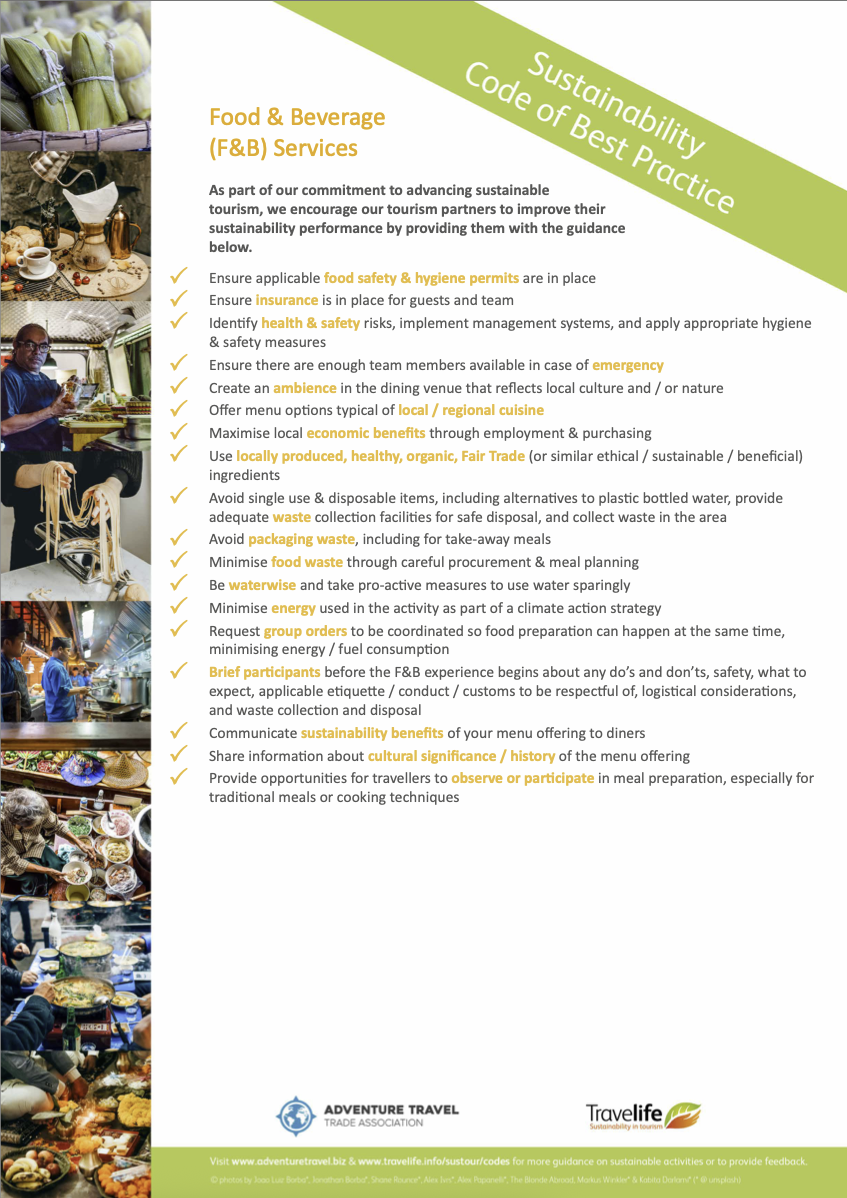
Source: ATTA/Travelife, 2022
If your business is in a UNESCO-recognised region for intangible cultural heritage, you are well-positioned to develop an authentic food experience that takes advantage of this status. Check the UNESCO List of Intangible Cultural Heritage to find out if your destination is listed there.
Plan your food experience
It is easy to see why food travel products are very common around the world. If you plan and implement your food tourism experience properly, with care and imagination, you will be able to make it stand out. Consider these important steps, too, as you plan and think about your market.
Table 1: Planning your food experience
| Area | Steps to take |
|---|---|
| Planning |
|
| Market considerations |
|
Source: Acorn Tourism Consulting, 2025
Local tour operator insight
I believe the most important elements of a successful culinary tourism experience are authenticity, high-quality ingredients and bold, fresh flavours. There should be a strong focus on traditional dishes and preparation methods, ideally guided by a local expert who can share the techniques and cultural context behind each plate. That human connection makes all the difference.
Of course, there are other essential factors as well, like offering the experience in multiple languages (English at least), ensuring high hygiene standards and having good facilities. These are sometimes taken for granted, but they are fundamental to delivering a high-quality product.
Another good practice is to combine gastronomy with other local activities. Very few travellers visit a destination just to try a single dish or learn how to prepare a single recipe. Destinations have so much more to offer, and food experiences are more meaningful when they are integrated with other cultural activities like making local crafts, playing music or being in nature.
This kind of combination not only enriches the overall experience but also gives travellers a better understanding of the place they’re visiting. It’s about creating a broader cultural journey, with food as the central thread that connects everything.

David Londoño Mejia, Awake Travel, Colombia
Be online and maximise social media activities
A strong online presence is essential in the food tourism business. Food looks very good in photos, and experiences are shared on social media, particularly Instagram and TikTok. There are also lots of travel bloggers who combine travel stories with food experiences. Your website and social media pages will help you be found by business buyers (B2B) and consumer buyers (B2C). However, this is a very busy space and you will need to work hard on your online presence to stand out.
Your website does not need to take sales, but you should make it very easy for customers to find out how they can book with you. This might be through a button to request a booking or a link to an OTA (online travel agent) where they can make a booking.
For Instagram and TikTok, you need to post regularly to keep content fresh and up to date. Your social media accounts should drive visitors to your website.
Two CBI studies focus on developing skills online and working with influencers to raise awareness: 'How to be a successful tourism company online' and 'How to work with influencers'. Read them to see how they can help you develop your business.
Tips:
- For helpful tips to create a successful food travel product, read the blog 'How to start a food tour business – a step by step guide'.
- Explore the World Food Travel Academy, part of the WFTA. It offers online training sessions for food tourism professionals, including master classes and certification. Improving your skills in this way will make it easier to understand food tourism at a deeper level.
2. Through which channels can you get food tourism products on the European market?
Food tourists are very diverse, and the European market is large. They research and buy products across a range of channels, including direct sales, tour operators and online travel agents (OTAs). All channels are important, but the most important for you depends upon what your food tourism product is. Having your own website is very important to inspire potential guests.
How is the end market segmented?
The food tourism market is large and diverse. People have very different motivations, tastes and behaviours when it comes to choosing a food tourism experience. Food tourism consumers can be split into the following broad groups:
- Authentic experience seeker;
- Social media foodie;
- Budget gourmet;
- Wellness-focused food traveller;
- Culinary connoisseur;
- Event-driven traveller;
- Family foodie.
Tip:
- To find out more about the different food tourist groups and what motivates them, read the CBI study on the European market potential for food tourism.
Through which channels does a product reach the end market?
Sales channels for food experiences are a combination of direct and indirect sales, as shown in the figure below.
Figure 3: Sales channels of food tourism experiences on the European market
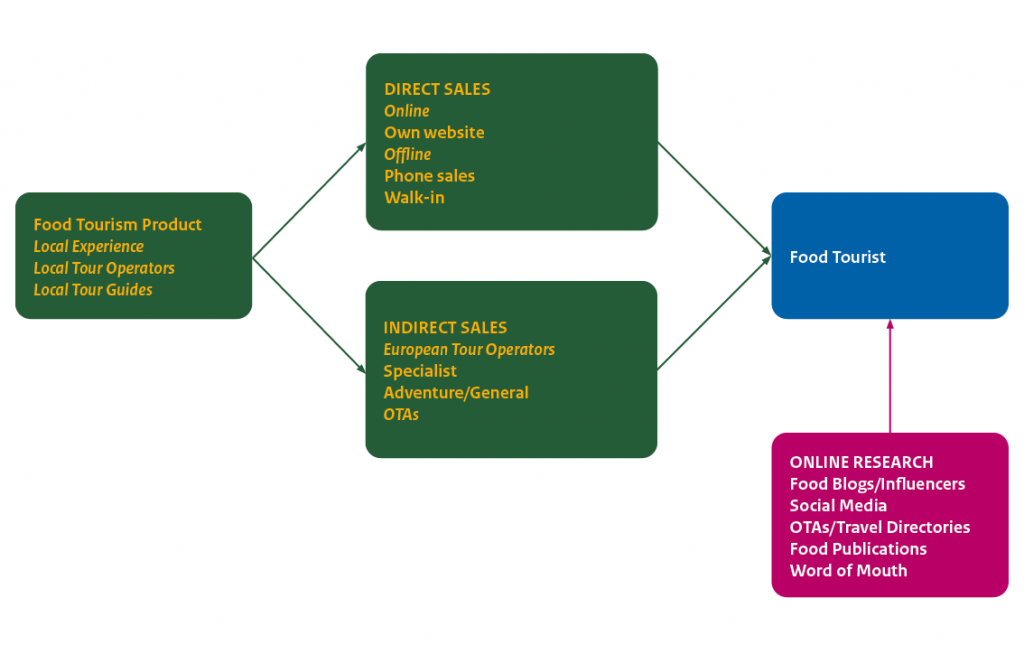
Source: Acorn Tourism Consulting, 2025
- Direct sales – If you have a website that can process online bookings or requests, fully independent travellers (FITs) can make direct bookings with you.
- Specialist operators – The European market has quite a small number of operators that specialise in food and drink trips. The UK has the most specialist food and drink tour operators. Examples include Grape Escapes and Wine Paths. Gourmet on Tour offers hands-on cookery courses, private wine tours and culinary adventures to destinations including Morocco, India, Sri Lanka, Thailand and Vietnam. Let’s Eat the World is a French operator that offers tours and workshops in Europe and South America.
- Adventure/general operators – Many large European tour operators offer food tours and food experiences within a broader itinerary that includes adventure and/or culture experiences. Examples include Intrepid Travel, Original Travel, Imaginative Traveller, Essential Escapes and Destinology. These UK-based tour operators also sell their products to European and North American clients. French adventure tour operator Terre Voyages has a gastronomic section that includes trips to various destinations. German operator Genussreisen specialises in culinary holidays around Europe. Dutch operator Better Places has culinary experiences as a theme.
- Online travel agents (OTAs) – OTAs that sell trips and travel experiences have become one of the fastest-growing platforms for sales. Food experiences are some of the most popular and best-rated experiences on platforms like Tripadvisor. Many OTAs include food, wine, cookery and culinary activities as a category of experience.
The table below shows OTAs that offer food experiences.
Table 2: OTAs offering food travel experiences
| OTA | Useful information |
|---|---|
| Traveling Spoon | Travelling Spoon specialises in providing home-hosted culinary experiences all over the world, connecting travellers with local people. |
| Airbnb Experiences | Airbnb reopened to new experiences in May 2025. There are a few food-related filters for customers to choose from: cookery, dining, food tours and tastings. |
| Eatwith is a large community for authentic culinary experiences with local people, available in more than 130 countries. | |
| Secret Food Tours offers luxury culinary activities in a small number of destinations, including Bangkok in Thailand and Hanoi in Vietnam. | |
| Viator and Tripadvisor | Cookery classes, dining experiences and other food/drink experiences are common across Viator and Tripadvisor, the largest OTAs that sell trips, tours and experiences today. Tripadvisor owns Viator, so trips that appear on one also appear on the other. |
| Evaneos | Evaneos is a French OTA that specialises in sustainable travel experiences. It co-creates travel experiences directly with customers. |
| GetYourGuide | GetYourGuide is a German-based experiences OTA. |
| Musement | Musement is an Italian-based experiences OTA. |
| TourRadar | TourRadar is an OTA that mainly offers multi-day trips. |
| Klook | Klook is a Hong Kong-based experiences OTA. |
Source: Acorn Tourism Consulting, 2025
Tips:
- Browse food experiences promoted across the different sales channels in your country or region. This will give you a good idea of the experiences popular with European food tourists.
- Have a look at culinary holidays or trips that European tour operators sell. This will help you understand what they want from their providers.
What is the most interesting channel for you?
Every sales channel is worth considering for your business, but the most important depends on the food experience you offer. If you target independent travellers who do not use European tour operators, your website and OTAs are the most important channels for you to consider.
However, you always need a website. European tourists use the internet a lot to research and book travel products. This means that it is very important that you have a business website. Your website also offers another way for European tour operators to find suppliers.
OTAs are fast-moving, dynamic sales platforms that are a major way for tourists to book experiences. There are lots of guides online to help you understand how they work and what you need to sell your experiences through them. You can start with the CBI study 'How to work effectively with OTAs'. The research company Arival specialises in the activities and experiences sector and publishes lots of free research. Its study 'An essential OTA checklist and tips for experience operators' is interesting to read.
Finally, travel software company Trekksoft has produced several useful guides including 'How to Work with OTAs – A Guide for Tour and Activity Companies'. It is free to sign up online. The more you can develop your knowledge of this sector, the more confident you will be.
Take a look at how to join each of the specialist OTAs using the following links:
- Traveling Spoon – Become a Host;
- Become a Host on Eatwith;
- Secret Food Tours – Join Us;
- Viator/Tripadvisor – Become a Supplier;
- To host an Airbnb Experience, click on the menu on the right-hand side to find ‘Host an experience’. You will need to sign up for the platform.
Figure 4: Sign up to host your product on Airbnb Experiences
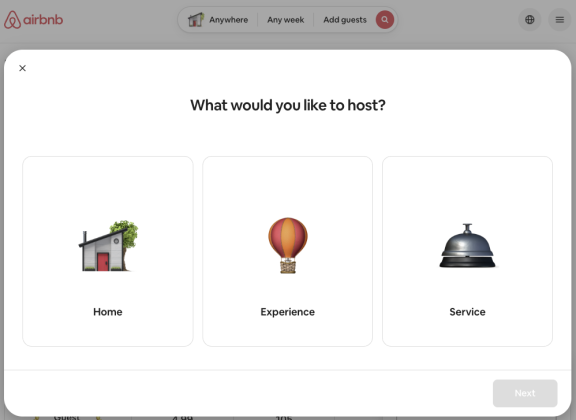
Source: Airbnb, 2025
Tips:
- For more information on building or improving your website, see the CBI study 'How to be a successful tourism company online'.
- To work effectively with European tour operators, consult the CBI studies '10 tips for finding buyers on the European tourism market' and '10 tips for doing business with European tourism buyers'.
- Find out more about the FIT (fully independent travellers) group. This type of traveller is very enthusiastic about cultural tours and often uses OTAs. For more information, read the CBI study 'What are the opportunities in the European FIT tourism market?'.
3. What competition do you face on the European food tourism market?
All countries compete as food tourism providers to some extent. Most countries’ cuisines reflect their heritage and culture. Such influences have led to widespread culinary fusions that use hugely varied ingredients.
Which countries are you competing with?
The top countries for food tourism are India, Peru, Vietnam and Morocco. You should also consider these countries as competing food destinations: Ethiopia, Indonesia, Mexico, the Philippines, Thailand and Türkiye.
India
Indian food is one of the world’s most popular cuisines. The word curry derives from the Tamil word ‘kari’ (spicy sauce), and Indian restaurants are common throughout Europe. Each region in India has its own distinct food identity, shaped by its history, from spicy curries in the south to rich Mughlai dishes in the north. It also has a strong vegetarian cuisine, one of the most diverse in the world.
The food tourism industry in India was worth around $13.7 billion (USD) in 2025. It is expected to grow to $58.6 billion in 2035. This represents a high CAGR (compound annual growth rate) of 15.6%. Growth is driven by the Indian government and regional tourist boards promoting food tourism experiences. Foodie hotspots include Delhi, Hyderabad, Rajasthan, Mumbai, Kerala and Kolkata.
The India Food Tourism Organisation (IFTO) is a non-profit membership organisation that works in several regions to promote and develop food tourism. The organisation helps to raise India’s culinary profile, supports street vendors and rural farmers and helps to preserve and promote traditional food skills and culture.
There are a lot of food festivals, including Grub Fest, India’s largest food festival, which returned to Delhi in September 2024 after a two-year break; the Sulafest in Nashik, a vineyard and music festival; and the Goa Food and Cultural Festival in April. All of these reflect the diverse cultures and traditions of the regions they take place in.
Street food in India is popular and accessible. It attracts large numbers of tourists who are keen to experience local flavours. However, travellers often cite food poisoning (or ‘Delhi belly’) as a concern. The Food Safety and Standards Authority of India (FSSAI) has implemented several projects to guarantee food safety, including Project Clean Street Food to train 20,000 roadside vendors in Delhi on health and hygiene.
Peru
Peru has become one of the world’s greatest food tourism destinations. It attracts many food tourists keen to sample the varied cuisine. Peruvian cuisine is a source of national pride. It is a unique blend of influences, including indigenous Andean, Amazonian, Spanish, African, French, Italian, Chinese and Japanese cuisines. Chefs say that many of their guests come from overseas, some specifically coming to Lima to experience the food.
Dishes range from Peruvian-Japanese fusion to ‘pachamanca’, a classic dish of slow-cooked meats and vegetables cooked over hot stones. Peru’s national dish is ceviche, marinated raw fish cured in citrus juice. It is a dish that dates back 2,000 years. In 2023, Peruvian ceviche culture was added to the UNESCO List of Intangible Cultural Heritage.
Peru’s food tourism offer ranges from high-end gastronomy to more accessible experiences like food trails and street food. Lima is thought of as the culinary capital of Latin America, and has many internationally renowned restaurants like Central, one of the World’s 50 Best Restaurants.
According to the Peruvian tourist board, more than 175,000 tourists visited Peru for its cuisine in 2023. Food tourists also spend more than regular tourists: an average of $124 (USD) per day. Other foodie hotspots in Peru include Cusco and Ica.
Vietnam
Vietnam has a diverse food offering, and dishes vary between the north and the south. Many traditional recipes date back hundreds of years. Famous dishes include Hanoian pho (noodles in broth with beef and chicken), bun cha (rice noodle and griddled pork), nem (spring roll) and bahn mi (a sandwich that originated in Saigon).
Food stalls and street food are common in Vietnam. Food tours are very popular, and trips to floating markets are a common tourism experience. The River Mekong dominates the southern region, which grows numerous fruits and vegetables.
Vietnam’s food tourism industry is attracting international attention and is growing fast. The food tourism market generated $222.7 million (USD) in 2023, and it is expected to generate $805.5 million by 2030. This represents a very high CAGR of 20.2% every year from 2024 to 2030.
The provision of food experiences is growing as local tour guides, families and communities look to provide authentic products. In 2024, OTA platform Klook reported a 70% increase in sales of food experiences, such as food tours and cookery classes. Vietnam has seven Michelin-starred restaurants – the only country of those profiled here to have any at all.
Vietnam Tourism has dedicated sections on its website for food tourism, with details of iconic dishes and destinations. It has also produced several interesting food infographics, like the ones below.
Figure 5: Vietnam – food tourism infographics
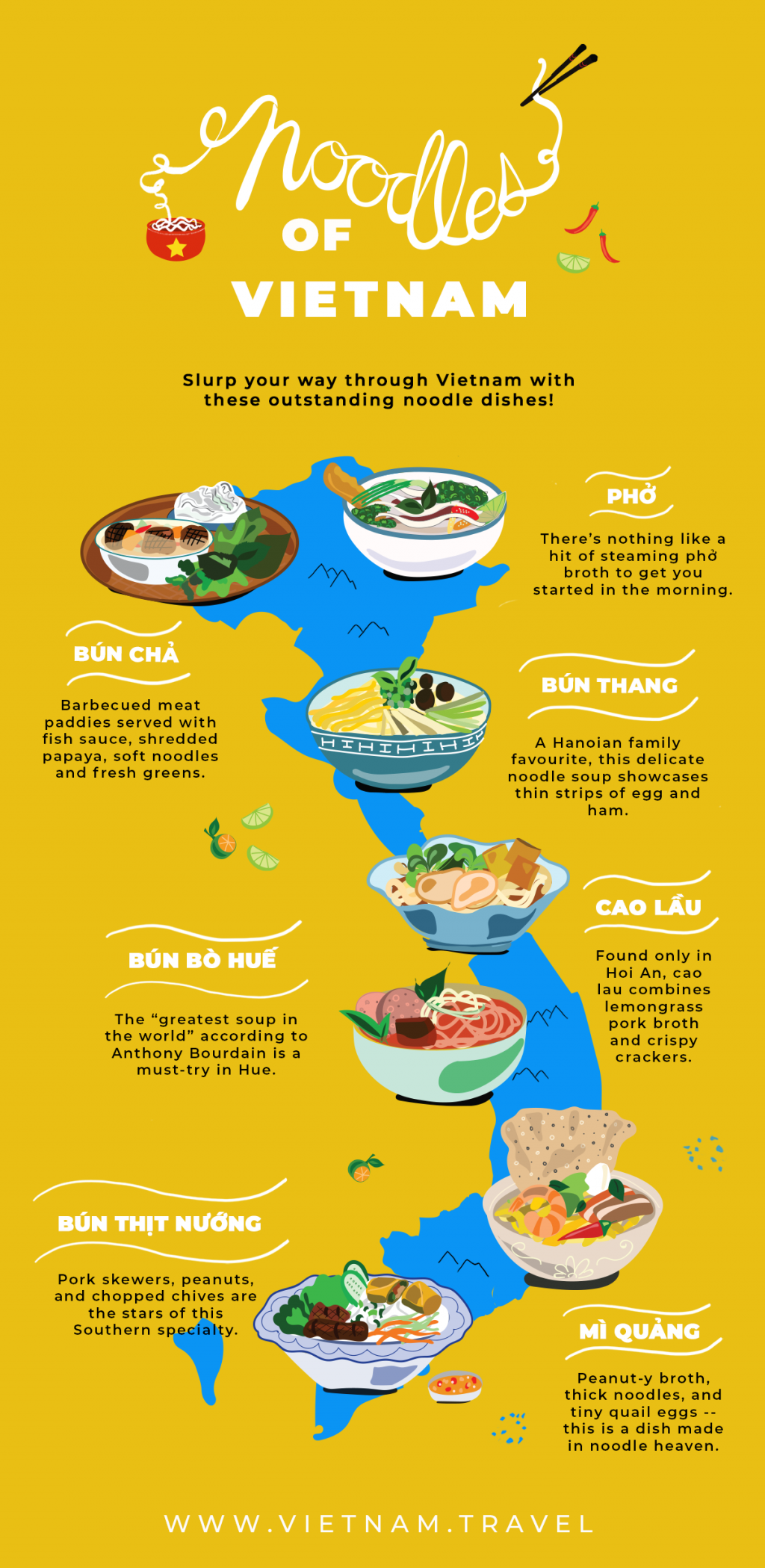

Source: Vietnam Travel, 2025
Morocco
Morocco has a rich, diverse culture and a wealth of natural and heritage attractions, including a strong, authentic food tourism scene. The cuisine is rich and inviting. Spices are a key feature, including coriander, cumin and saffron. Morocco is the most popular African destination for Europeans, and its diverse food offerings and immersive experiences attract travellers who want authentic experiences. Food and wine tourism is very highly regarded for its sustainability. Visit Morocco includes Gastronomy as a feature of the nation’s cultural offer.
The centre of Moroccan cuisine is Marrakech, famous for its souks (markets) and many local artisan producers of local specialities, including the traditional slow-cooked casseroles served in traditional tagines – iconic clay cooking pots with a conical lid – and couscous. Originating in Fez, b’stilla is a sweet pigeon-meat pie, while the heavily sweetened mint tea often referred to as ‘Moroccan whisky’ is the local drink of choice.
Street food tours are common, especially in the tourist hotspot of Djema el Fna, and there are many cookery classes. Food tourism experiences are also possible in rural destinations such as the Ait Bouguemez Valley, where travellers can learn to cook with Berber communities. In Sefrou, the Cherry Festival – a UNESCO-recognised event – is held every June.
Key takeaways
- One of the main challenges for developing destinations is food hygiene, particularly relating to street food. Many countries are looking for ways to reduce the danger of food poisoning. Make sure that you focus on keeping your customers safe.
- Many different types of food experience exist, and the number is growing constantly. Make sure that you research what is already available so that you create an experience that will help you stand out.
- Add value to your food experience by combining it with other cultural activities.
Which companies are you competing with?
Every country is home to many food tourism businesses, and the market is very crowded. However, because there are so many different ways to tell a food story, there are still many opportunities. Take a look at the businesses below to see what you can learn from them.
India
No Footprints is based in Mumbai and offers a range of tours that focus on food, communities and culture. It aims to give a voice to marginalised groups, such as refugees and LGBTQ+ people. Food experiences include the Khau Gully Street Food Tour, a seven or eight-course journey through Mumbai’s legendary food spots. This was voted one of the 20 best food tours by the Guardian in 2019. A new tour, the Bandra Food Walk, aims to discover Mumbai’s lesser-known food culture. This operator is now also active in Delhi and Jaipur.
No Footprints has won several awards, including a #1 Tripadvisor ranking every year since 2020, which it shows on its homepage. Its tours have been featured in many international publications. All the bestsellers are mentioned on the homepage. Each tour is fully described, and there are videos that go with them.
Delhi Food Walks has won the hearts of many visitors and experts over the years. This operator offers several day and night walks, as well as immersive experiences such as 'Cook and Eat with a Local Family'. Its website is interesting and uses both images and videos. It features a lot of international testimonials on its homepage, and links to its Tripadvisor page. It also displays its environmental credentials through a clear and informative infographic.
Figure 6: Delhi Food Walks – health, hygiene and environmental statement

Source: Delhi Food Walks
Delhi Food Walks features links to all its social media, including its YouTube channel, on its homepage. This is a best practice when trying to attract European customers. Europeans use the internet a lot to research trips. The website has sections for both blogs and vlogs, and it has been featured in many international publications.
Peru
Lima Gourmet Company offers small group and private tours, including tastings and hands-on activities such as cookery classes and making pisco sour, a local speciality. Each tour is well described, with many attractive images. Its website looks fresh and inviting, with a wide range of images, infographics and content. The blog sections offer additional information about visiting Peru, Peruvian recipes and restaurant recommendations.
Curious Monkey Food Tours operates food tours in Cusco and Arequipa. They include 'Earth to Table in the Sacred Valley', which involves a meal with a local family, and the 'Market and Streets Tour' in Cusco to taste tamales (steamed filled buns) and cherimoya (custard apple fruit). The website features lots of images of customers enjoying food tours.
Vietnam
The Original Taste of Hoi An operates one food tour, which is conducted in two parts: a walking tour of markets and streets and meeting a range of producers, then a private tasting. Guests learn the different names of the foods, including how to say them. Learning about Vietnamese culture also plays a big part. This operator won the Global FoodTrekking Award in 2019, presented by the WFTA for Best Food Travel Storytelling, and has received more than 1,500 reviews on Tripadvisor since 2011.
XO Tours offers food tours by scooter/motorbike, all led by women. Several are in Ho Chi Minh City. The most popular tour there is the OX Foodie tour, which visits the most popular street stalls and hidden alleyways, focusing on street food dishes that are not commonly available outside Vietnam. Conducted at night, the tour goes to parts of the city not typically visited by tourists.
Morocco
Moroccan Food and Family Adventures sells tours and street food experiences in Marrakech, Essaouira and Tangier for travellers who want to ‘taste, learn and connect’. This is a great example of a USP being used to good effect. Tours are conducted in English and include storytelling and history to bring the destination to life. The website has recently been updated. It looks vibrant and inspiring, with lots of good images and clear text. This operator offers both one-day and multi-day trips.
The website features infographics to tell customers about the operator’s followers, and links through to each platform. That is an effective call to action.
Figure 7: Moroccan Food and Family Adventures: reviews, ratings, likes and followers

Source: Moroccan Food and Family Adventures, 2025
Fes Food Tours invites customers to see the ‘real Fez’. It has three tours that involve tasting, experiencing the culture and learning about Morocco’s unique way of life. The website is simple, clear and appealing to a European audience. Bookings can be made online, and each tour is fully described and accompanied by good images and a Google map.
Key takeaways
- Having a website is a very good way to sell food experiences. It is the window to your business and is often how your customers will find you. Food is very photogenic and easy to display. A website with great images and videos will make sales for you.
- Tours that focus on storytelling and communities are key to immersive food experiences. Participants can learn through tasting. It helps to bond with the host community.
- Travel to lesser-known foodie hotspots is a common theme among food experience providers and is often more authentic.
Which products are you competing with?
The main competing products for food travel experiences include cultural and community-based tourism (CBT) travel products. Both types can include food elements. To find out more about each of these niche markets, read the CBI studies 'What are the opportunities for community-based tourism from Europe?' and 'What are the opportunities for cultural tourism from Europe?'.
4. What are the prices of food tourism on the European market?
Prices for food travel experiences vary a lot. Depending on whether the experience is a tasting or a hands-on experience, costs will usually include multiple items, such as ingredients, a guide, refreshments, transport and fees. The table below offers some examples of the price differences between product type and destination. Prices exclude air fares.
Table 3: Examples of prices for food experiences in competing destinations
| Tour description | Country | Duration | Price from, per person (€) |
|---|---|---|---|
| Traditional Moroccan Tea Ceremony | Morocco | 1 hour | 15 |
| Hoi An Street Food Walking Tour with Tastings | Vietnam | 4 hours | 30 |
| Chandni Chowk – Delhi Food Tour | India | 4 hours | 30 |
| Authentic Alleyways Food Tour | Morocco | 2.5 hours | 48 |
| Fez Food Experience | Morocco | 3–4 hours | 55 |
| Market and Streets Tour, Cusco | Peru | 2.5 hours | 61 |
| Hanoi Dawn – Hanoi Food Tour | Vietnam | 4 hours | 65 |
| The XO Foodie Tour | Vietnam | 4.5 hours | 71 |
| Cookery Class in Lima | Peru | 3 hours | 78 |
| Jaipur Chef Special | India | 4 hours | 119 |
| Lima Gourmet Food Tour | Peru | 5 hours | 121 |
| Khau Gully Street Food Tour, Mumbai | India | 3 hours | 134 |
Source: Acorn Tourism Consulting, 2025
Tips:
- When setting your prices, include all the elements in the cost before working out how much to charge. Do not forget to factor in the commission you will have to pay an OTA if you sell your tour through one.
- For help with setting your prices, read the CBI study '10 tips for doing business with European tourism buyers' and scroll to tip 8, ‘Set a fair price for your services’.
Disclaimer: The statistics quoted throughout this study are drawn from a range of sources. Due to variations in data collection and presentation methods, figures may not always be directly comparable.
Acorn Tourism Consulting Limited carried out this study on behalf of CBI.
Please review our market information disclaimer.
Search
Enter search terms to find market research
